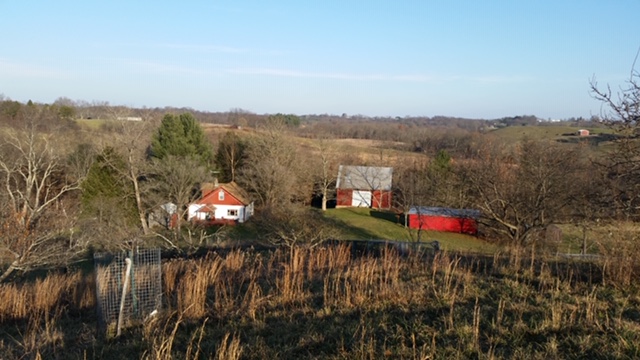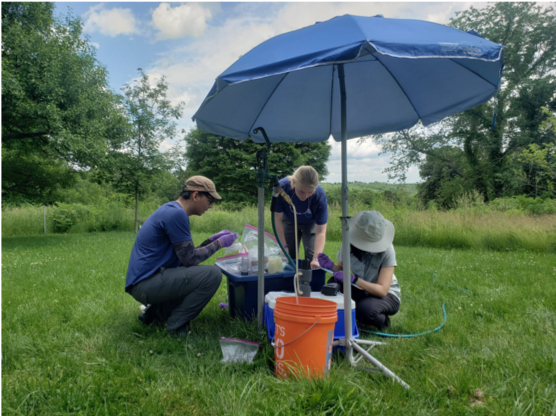
Helen Siegel / Courtesy
The Yale team conducts water sampling in eastern Ohio.
The Yale University project could help residents know where to point a finger when well water becomes contaminated.
Rob Reed is happy to have clean well water at his family’s Monroe County, Ohio, fruit farm.
But in a region rife with fossil fuel extraction, worries about contamination loom.
“It seems like eastern Ohio is always under assault from some entity or another, whether it’s an underground coal mine or fracking for natural gas or whatever it is,” Reed said. “They’re always drilling holes and making tunnels under the earth. Of course, that’s where the water comes from.”
Samples from the Reeds’ well are among hundreds being analyzed by Yale University researchers who hope to better understand how different types of fossil fuel activity affect groundwater. The study might give some residents a clearer view of where to point a finger if wells do go bad.
Results could bolster claims for damages in some future cases or potentially absolve one industry or another in other situations. More generally, the work can provide important insights for lawmakers and regulators.
“We’re just trying to get good quality information for policymakers,” said Helen Siegel, a graduate research fellow on the project. The work focuses on Belmont and Monroe counties, which have not been the focus of much prior research.
 The Reed farm. (photo courtesy of Bev Reed)
The Reed farm. (photo courtesy of Bev Reed)
Reed has lived in Appalachian Ohio his whole life except for a stint in the armed forces. The farm near Beallsville grows blueberries, apples, and pears. The family also owns a small bicycle and appliance shop in Bridgeport, near the Ohio River.
The poverty rate in Monroe County was almost 17% in 2018. Belmont County fared somewhat better, with an overall poverty rate of roughly 13%. But there are wide disparities among cities and towns in that county. St. Clairsville, where Murray Energy is headquartered, had roughly 1 in 20 children living in poverty. In contrast, Martin’s Ferry had more than 1 in 4 children living in poverty.
Impacts from coal mining and natural gas drilling have varied as well, Rob Reed said. “I see the degradation of the area, and some parts of the county have been spared more than others.”
“One of the challenges of working in this area is that you have a long history of extractive industries,” Siegel said. That makes it harder to sort out which industry might have affected residents’ groundwater, which is the only source for most farmers in the primarily rural counties.
Geology complicates matters more. “In the north, you have more of this coal-strata-dominated water, so you have a lot of sulfate,” Siegel said. “And then in Monroe County in the south, you have more of this shale-dominated geology.”
“Teasing apart this human-impacted versus the natural water chemistry signature is challenging right now,” she said. Plus, the geology is very mixed. “We’ve got a series of coal, limestone, sandstone, soapstone, and shales, that are all interbedded,” Siegel said. In other words, the geologic layers aren’t neatly stacked like the tiers of a layer cake. They’re more like the rippling and sometimes overlapping color bands of an intricate sand art jar.
Siegel’s team visited 162 homes in the two counties, where members interviewed residents and collected at least one set of 12 untreated water samples. If homes had a sediment filter, water softeners, or other treatment, the team took an additional set of 12 samples from the kitchen tap or another spigot. “Participants received both sets of results in the mail,” she said.
Confidentiality agreements precluded Siegel from saying if any homeowners’ wells didn’t meet safe drinking water standards.
 The Yale team conducts water sampling. (photo courtesy of Helen Siegel)
The Yale team conducts water sampling. (photo courtesy of Helen Siegel)What testing can show
When Siegel’s team offered to test his family’s well for free, Reed signed up. “We’re just trying to see if there’s any changes in our water from the time we had it until now,” he said.
The well was tested about a decade ago when a nearby coal mine wanted to do longwall mining underneath the farm. The undermining didn’t go forward, but the results provide one snapshot of the Reed farm’s water quality. More testing took place about two years ago when a natural gas company planned to drill nearby.
Then the Yale group came. “So we’re going to have a historical analysis of if there’s been any changes,” he said. That could matter in any future case for property damage. For other families, the Yale group’s testing was the first snapshot of their well’s water quality.
“It is extremely difficult without a time series to say for certain what has changed with the arrival of this new industry of unconventional oil and gas expansion,” Siegel said. Work by her team could help shed light for the future on what sources are more or less likely when contaminants are found.
“What we’re trying to do with the study is use our physical models and use our water chemistry to trace back the sources to see if there’s a widespread impact,” she explained. Physical models use principles of physics and chemistry to figure out how groundwater or contaminants would travel through the area’s geologic layers.
Water chemistry looks at particular isotopes to see whether they are more likely to have come from coal or natural gas-related activities or from some other process. Methane from deep in the ground will have different isotopes in it than that which might form from decaying matter closer to the surface, for example.
Water testing can also reflect some indirect impacts of industry activity. For example, Siegel said, testing results suggested possible impacts from the use of road salt in the area. Areas with lots of shale gas drilling and fracking often have increased levels of traffic, which can lead to more salting in the winter.
Siegel had planned to present a preliminary report on the work at the American Chemical Society Meeting in Philadelphia last month, which was cancelled due to the COVID-19 pandemic. The team is now working remotely to complete analysis and hopes to publish several papers later this year or next year.
An earlier study focused mainly on other Ohio counties and had a narrower scope of testing parameters. That team found some wells with high levels of methane that seemed to have originated in coal, rather than shale.
“That doesn’t necessarily mean coal mining. … It could just be coal that’s under the ground,” said geologist Amy Townsend-Small at the University of Cincinnati, who was one of the study’s authors.
That’s where physical modeling of the type Siegel’s team seeks to incorporate might help. Residents might have a stronger case for claiming damages if multiple wells had high concentrations of coal- or shale gas-linked isotopes downgradient from industry activity, for example. Conversely, industry might have a stronger defense if the isotopes were found upgradient from drilling activity.
Hopes for the future
Ideally, residents hope testing shows that their well water meets safe drinking water standards. And they hope that continues.
“When you live in a remote rural area and you rely on groundwater, once your water gets contaminated you won’t be able to live there anymore,” Townsend-Small said. “There’s no option for getting city water in many of these areas.”
That matters to the Reed family and many of their neighbors in the Beallsville area. In addition to being a source of food and income, it’s a place of quiet and respite.
“We like to go there to relax and get away from the stresses of the valley,” said Rob Reed’s adult daughter, Bev. Meanwhile, her dad continues his work at the shop and travels throughout the area for appliance repairs.
“I wish that there would be some other industry that would come in that had a cleaner tech to it,” he added. “That wouldn’t leave a wake of mine drainage and air pollution and water pollution and all the things that go along with fracking and that sort of thing. But that doesn’t seem to be happening around here.”
Original source: Energy News Network